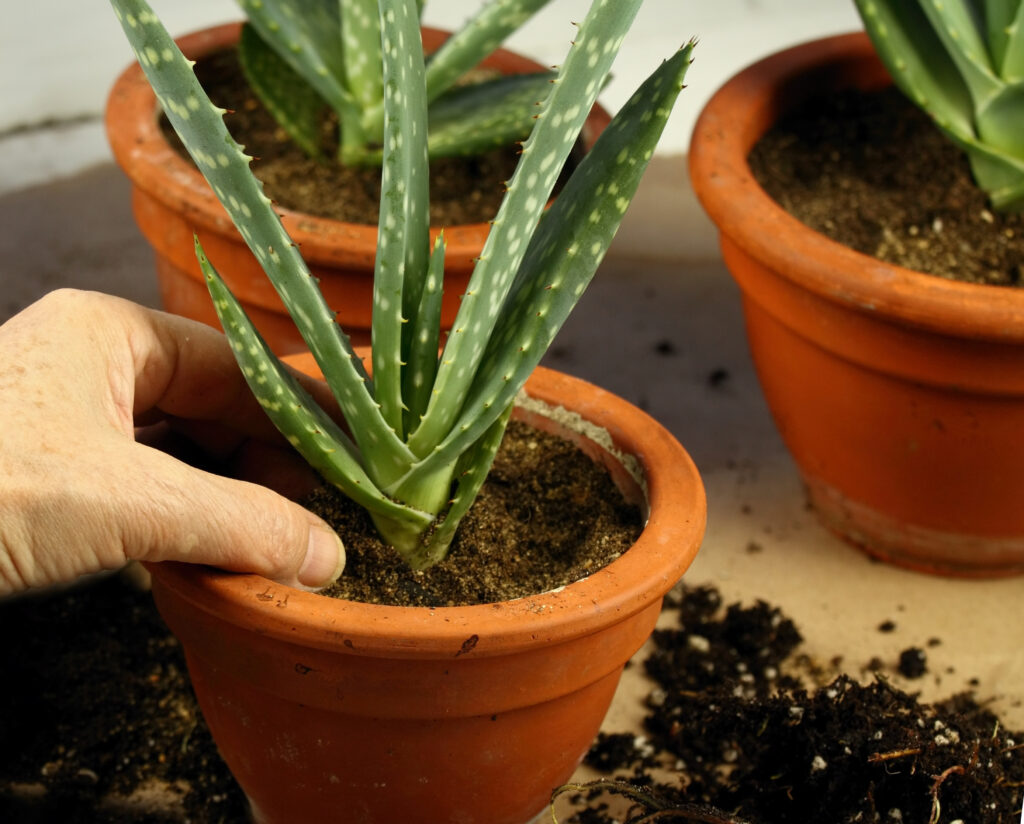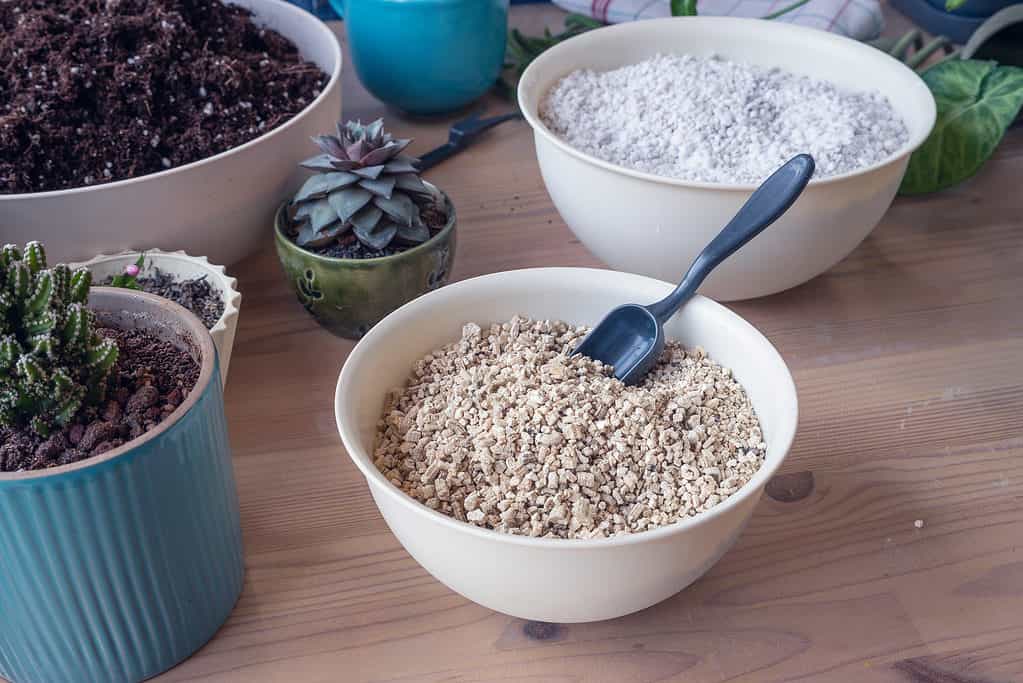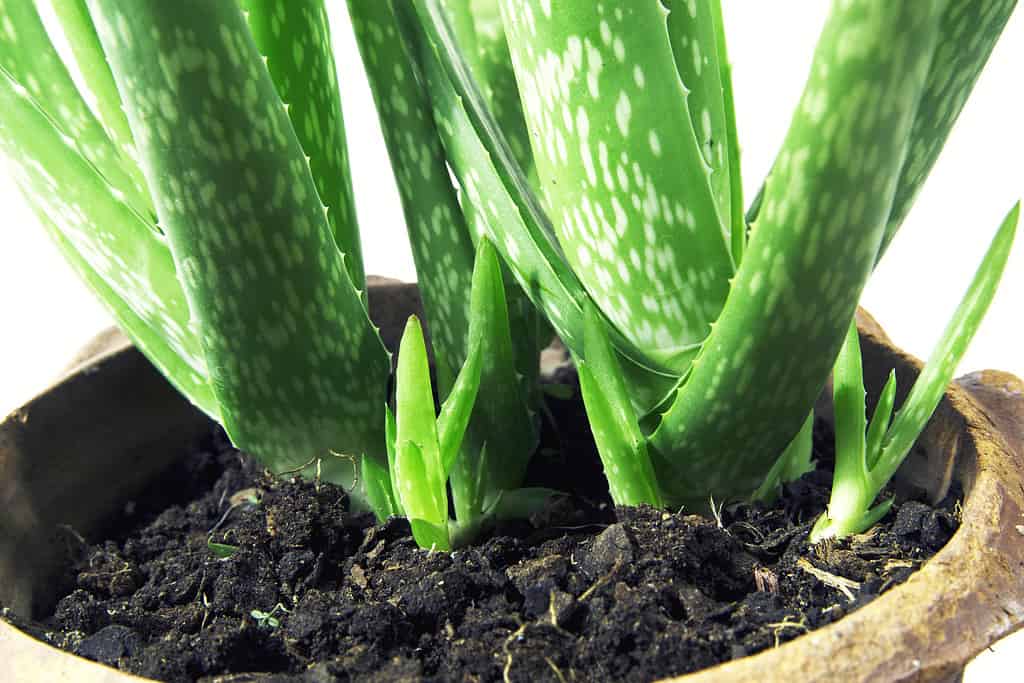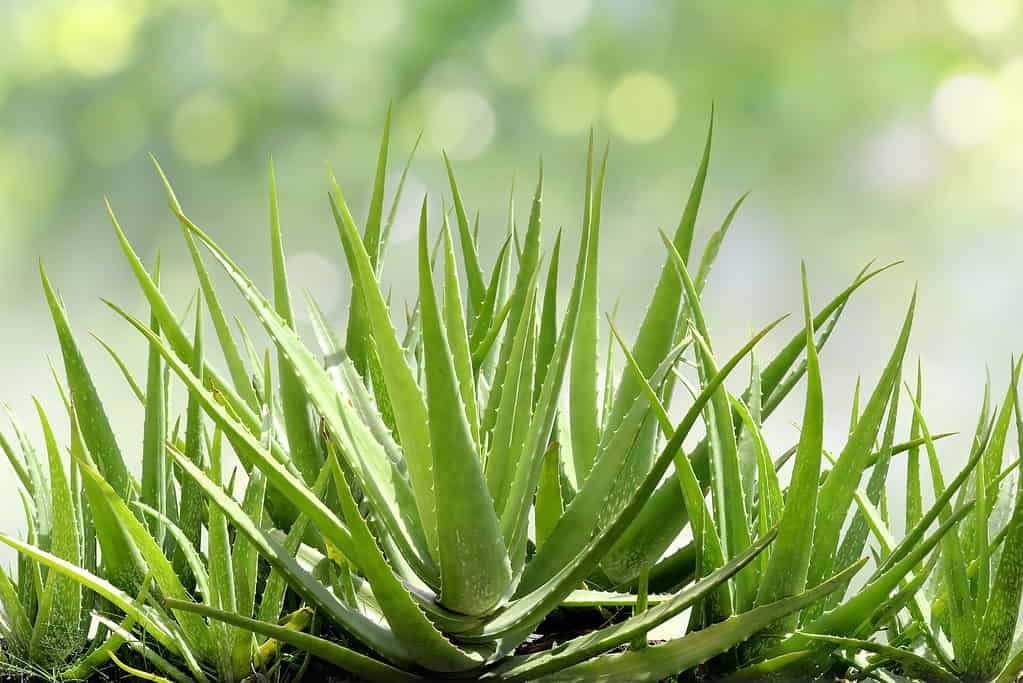The Best Soil for an Aloe Vera Plant: Top Mixes and 10 Critical Care Tips
Aloe is one of the most recognizable and cherished indoor plants. Not only is it easy to care for and nice to look at, but it also contains a nutrient-rich gel that promotes healing for common skin ailments like sunburns and eczema.
Finding the right soil for your aloe vera could be the difference between a plant that survives and a plant that thrives. In this article, we’ll cover the best soil for an aloe vera plant, including key features, DIY soil recipes, and critical care tips.
Let’s dig in!
The Best Soil for an Aloe Vera Plant: Key Features

©iStock.com/svehlik
Drainage is everything when choosing soil for an aloe vera plant. It should have a blend of organic and inorganic materials, with space for water and air movement. Aloe vera soil typically contains a blend of regular potting soil and larger, texturized chunks of matter to prevent one of aloe’s biggest weaknesses: root rot.
Aloe vera is a succulent, so you can plant it in pre-mixed succulent soil from your local garden center with success. Alternatively, you can create your own blend and experiment to determine what works best for your plants.
The Best Soil for an Aloe Vera Plant: Common Ingredients

©iStock.com/CemSelvi
When creating a soil blend for an aloe vera plant, there are several key organic and inorganic ingredients you can choose from to make your own mix:
Potting Soil
Regular potting soil is not appropriate for an aloe vera plant, as it retains too much moisture and will lead to root rot in succulents. However, it’s a good foundation of organic material to start with when creating a soil blend.
Pine Bark
Pine bark offers two overarching benefits when added to aloe vera soil. First, it’s an organic material that adds nutrients to the mix as it breaks down. Second, it creates drainage and airflow in the soil to move water away from the roots.
Coco Coir
Coco coir (also known as coconut coir) is a controversial ingredient in the gardening world. This organic material doesn’t offer much on its own. It lacks the rich nutrients of pine bark and doesn’t retain moisture effectively. However, it works well to add drainage when blending with potting soil.
Compost
Mixing some compost into your potting soil will provide additional nutrients to your aloe vera and offset deficiencies caused by high levels of inorganic material.
Coarse Sand
Coarse sand is one option for adding drainage to your potting soil. It offers a bit of water retention so the water won’t run through the pot too fast, but doesn’t hold the moisture long enough to do damage.
Always purchase builder’s sand with medium to coarse grit. Never collect sand from the beach as the microorganisms and salt content could harm your plant.
Perlite
Perlite is another inorganic mineral addition to your potting soil for drainage. The benefit of perlite is that it’s lightweight and adds plenty of airflow and drainage to regular potting soil to make it suitable for aloe and other succulent plants.
Pumice
Pumice is a porous volcanic glass that’s often used in the beauty industry; you may recognize it as a pumice stone.
Many plant parents prefer pumice over perlite as it’s heavier and more structured. However, it tends to be more expensive than perlite and not as readily available.
Fine Gravel
In a pinch, fine gravel will work in soil for an aloe vera plant. It’s important to mix the gravel into the soil rather than layering it at the bottom of the pot.
Diatomaceous Earth
Diatomaceous earth isn’t a common ingredient in most pre-mixed succulent soil, but it’s a powerful ingredient in DIY blends. This fossilized material helps with drainage and airflow while offering the added benefit of deterring common pests.
DIY Soil for an Aloe Vera Plant

©S_Sukporn/Shutterstock.com
Aloe vera grows naturally in the desert and prefers a well-draining, gritty soil. The ideal ratio of materials is typically:
- 2 parts organic matter
- 2 parts sand
- 1 part grit
However, depending on your climate, you may adjust the ratio. For example, if you live in a hot, dry region, you may put more organic matter and less sand to help retain a bit of moisture during drought periods. Conversely, if you live in a humid area, you may increase the ratio of sand and grit for better drainage.
Here are a few examples of DIY aloe soil recipes:
Aloe Soil Recipe 1
For a basic blend, try:
- 1 cup potting soil
- 1 cup coco coir
- 2 cups sand
- 1 cup perlite or pumice
Aloe Soil Recipe 2
For a nutrient-rich blend, try:
- 1/2 cup potting soil
- 1/2 cup compost
- 1 cup pine bark
- 2 cups sand
- 1/2 cup perlite or pumice
- 1/2 cup diatomaceous earth
Aloe Soil Recipe 3
For more drainage, adjust the ratio and try:
- 1 cup compost
- 1 cup coco coir
- 1 cup coarse sand
- 1 cup perlite
Get creative and try various blends with the offsets of your aloe plant to see what works best in your environment.
Critical Aloe Vera Plant Care Tips

©iStock.com/cgdeaw
Now that you know how to choose the best soil for your aloe vera plant, try these critical care tips to help your plant thrive.
1. Provide Plenty of Sunlight
Aloe grows in the desert and loves full sun exposure. Place this sun-loving plant in a bright window where it will receive 6-8 hours of sunlight per day. If this isn’t possible, substitute with a grow light.
If you live in a cold area and like to move your plants outdoors in the summer, be cautious. Aloe needs a transition period before being placed in direct, overhead sunlight.
2. Choose a Well-Draining Pot
Your perfect soil blend won’t make a difference if you choose a pot without proper drainage holes. Aloe will grow and thrive whether you choose ceramic, clay, or plastic pots, but drainage holes are non-negotiable.
3. Watch for Common Pests and Diseases
Aloe is susceptible to the same pests that target other succulents, such as mealybugs, spider mites, and scale insects. It’s also prone to root rot and fungal growth when overwatered.
4. Provide Airflow
Aloe requires a lot of airflow to stay dry and happy. While you can plant these in a terrarium, they aren’t the best choice. If you plant your aloe vera in a terrarium, choose one with a wide, open top for airflow.
5. Avoid Vents and Drafts
Cold drafts or extreme temperature fluctuations will kill your aloe vera plant. Unfortunately, the signs of cold shock may not become apparent for days after it happens, meaning you could leave your aloe in the same spot and increase the damage without knowing.
Be sure to place your aloe away from vents or drafty windows, especially during the colder months.
6. Prepare for Dormancy
Like most succulents, aloe vera goes into a dormant state during the winter. Prepare it by avoiding propagation, repotting, and fertilization in the fall and winter months. Reduce watering and let it rest to promote growth in the spring.
7. Fertilize in the Spring
When the growing season starts, you can fertilize your aloe vera plant with organic matter or a standard succulent fertilizer.
8. Transplant Offsets
Give your aloe plants room to grow by transplanting offsets. Healthy aloe plants will grow individual pups beside the parent plant. In the spring, you can separate these and give them their own pot. This ensures you have some backup aloe if something goes wrong and provides ample room and nutrients for healthy growth.
9. Cut Sparingly
Cutting the aloe and using the gel is a great way to soothe sunburns or minor kitchen accidents. However, overcutting will harm your plant.
Cut sparingly, using only established leaves. Always use clean cutting tools and let your plant heal.
10. Avoid Extra Drainage Materials
As mentioned previously, gravel is an effective addition to potting soil to improve drainage for an aloe vera plant. However, it shouldn’t be layered at the bottom of the pot. Doing this takes up room for root growth and leads to damage, as the roots will be unable to derive nutrients from this area. It could also lead to root rot.
The photo featured at the top of this post is © iStock.com/klenova









